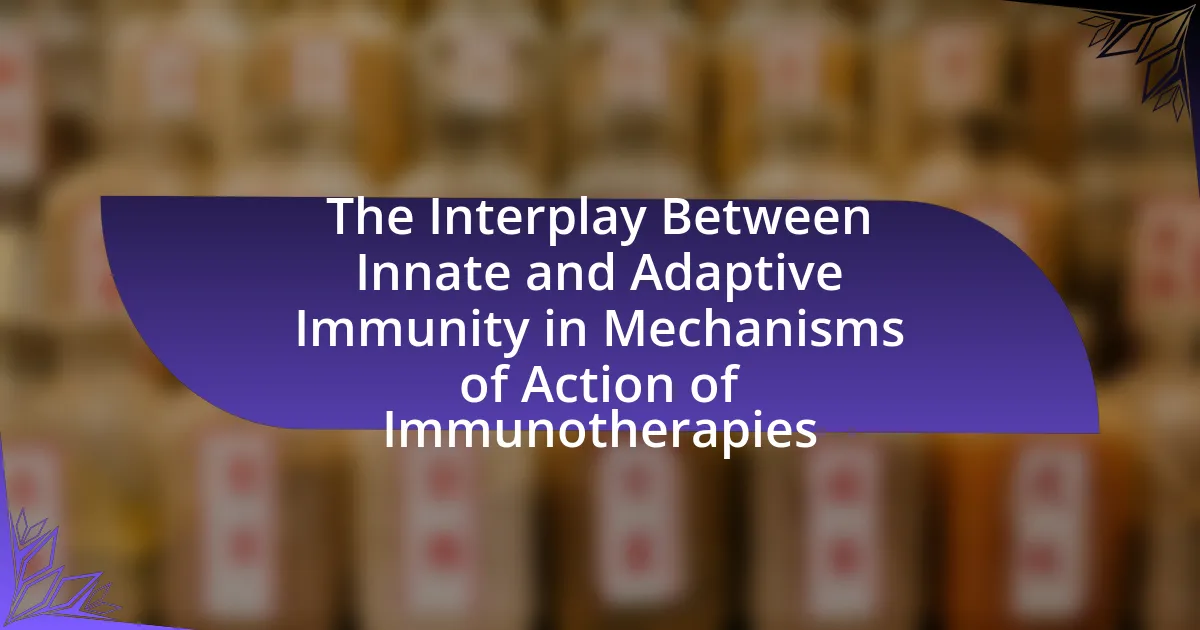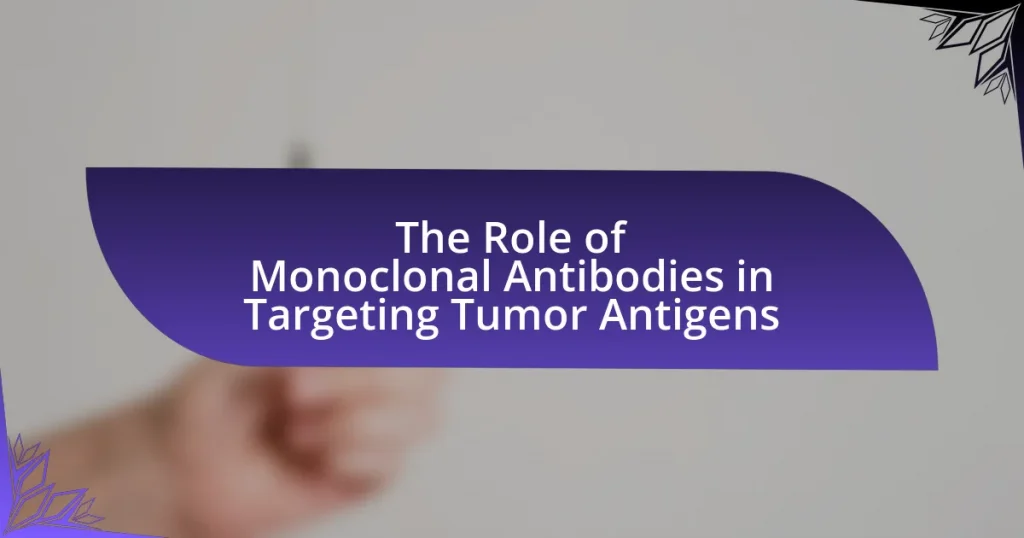The article examines the interplay between innate and adaptive immunity in the context of immunotherapies, highlighting its significance in enhancing treatment efficacy against diseases such as cancer. It details how innate immunity provides an initial response through mechanisms like natural killer cells and macrophages, which shape the adaptive immune response involving T and B lymphocytes. The article further explores the roles of key immune components, the importance of understanding their interaction for developing effective therapies, and the implications for patient-specific treatments. Additionally, it addresses the challenges and limitations of current immunotherapy strategies, while emphasizing the potential of innovative approaches and personalized medicine to improve outcomes.
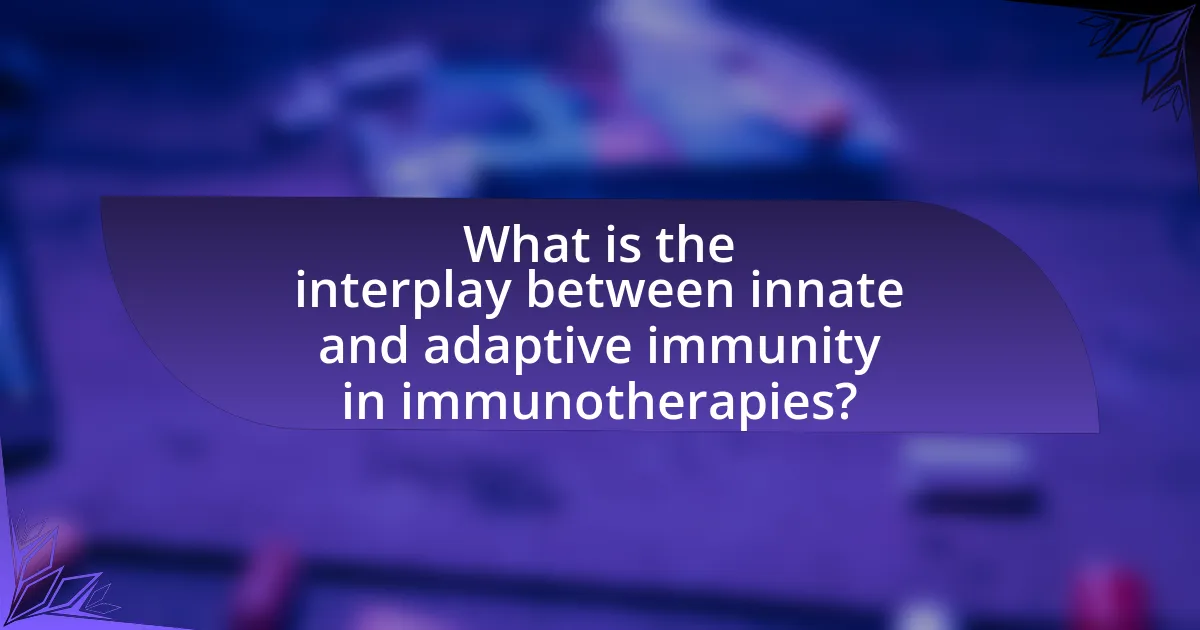
What is the interplay between innate and adaptive immunity in immunotherapies?
The interplay between innate and adaptive immunity in immunotherapies is crucial for enhancing therapeutic efficacy against diseases like cancer. Innate immunity provides the initial response to pathogens and tumor cells through mechanisms such as the activation of natural killer cells and macrophages, which can recognize and eliminate abnormal cells. This early response is essential for shaping the adaptive immune response, which involves T and B lymphocytes that specifically target and remember antigens associated with tumors.
Research indicates that innate immune cells can produce cytokines that promote the activation and proliferation of adaptive immune cells, thereby bridging the two systems. For example, dendritic cells, a component of the innate immune system, play a pivotal role in presenting antigens to T cells, facilitating their activation and differentiation into effector cells capable of targeting tumors. Studies have shown that therapies combining innate and adaptive immune mechanisms, such as checkpoint inhibitors and vaccines, can lead to improved patient outcomes by leveraging this interplay to create a more robust and sustained immune response against cancer.
How do innate and adaptive immunity differ in their roles?
Innate immunity provides the first line of defense against pathogens through immediate, non-specific responses, while adaptive immunity develops a targeted response over time, characterized by memory and specificity. Innate immunity includes physical barriers like skin, as well as immune cells such as macrophages and neutrophils that respond quickly to infections. In contrast, adaptive immunity involves lymphocytes, specifically T cells and B cells, which recognize specific antigens and can remember past infections, allowing for a more efficient response upon re-exposure. This distinction is crucial in immunotherapy, as therapies often aim to enhance adaptive immune responses while utilizing innate mechanisms for initial pathogen recognition and response.
What are the key components of innate immunity?
The key components of innate immunity include physical barriers, immune cells, and soluble factors. Physical barriers, such as skin and mucous membranes, prevent pathogen entry. Immune cells, including macrophages, neutrophils, and natural killer cells, provide rapid responses to infections. Soluble factors, such as cytokines and complement proteins, facilitate communication between immune cells and enhance the immune response. These components work together to provide immediate defense against pathogens, highlighting the essential role of innate immunity in the overall immune response.
What are the key components of adaptive immunity?
The key components of adaptive immunity are T cells, B cells, and antibodies. T cells, which include helper T cells and cytotoxic T cells, play crucial roles in recognizing and responding to specific antigens. B cells are responsible for producing antibodies that bind to antigens, neutralizing pathogens, and marking them for destruction. Antibodies, which are proteins produced by B cells, specifically target and eliminate foreign substances. This specificity and memory characteristic of adaptive immunity enable a more robust and rapid response upon subsequent exposures to the same pathogen.
Why is understanding this interplay important for immunotherapy?
Understanding the interplay between innate and adaptive immunity is crucial for immunotherapy because it enhances the effectiveness of treatment strategies. This interplay determines how the immune system recognizes and responds to tumors, influencing the development of therapies that can activate or modulate these immune responses. For instance, studies have shown that innate immune cells, such as dendritic cells, play a pivotal role in priming adaptive immune responses, which are essential for long-term tumor control. By comprehensively understanding this relationship, researchers can design more targeted and effective immunotherapies, leading to improved patient outcomes and survival rates.
How does this interplay influence treatment outcomes?
The interplay between innate and adaptive immunity significantly influences treatment outcomes in immunotherapies. This interaction enhances the overall immune response, as innate immunity can activate and shape adaptive responses, leading to more effective tumor targeting and destruction. For instance, dendritic cells, a component of innate immunity, present antigens to T cells, facilitating their activation and proliferation, which is crucial for a robust adaptive immune response. Studies have shown that patients with a strong innate immune response often exhibit better responses to therapies such as checkpoint inhibitors, as evidenced by research published in “Nature Reviews Immunology,” which highlights the correlation between innate immune activation and improved clinical outcomes in cancer patients undergoing immunotherapy.
What are the implications for patient-specific therapies?
Patient-specific therapies have significant implications for personalized medicine, particularly in the context of immunotherapies. These therapies are designed to tailor treatment based on individual patient characteristics, including genetic, environmental, and lifestyle factors, which can enhance therapeutic efficacy and minimize adverse effects. For instance, studies have shown that utilizing biomarkers to guide immunotherapy can lead to improved outcomes in cancer treatment, as seen in the use of PD-1 inhibitors in patients with specific tumor profiles. This approach not only optimizes the therapeutic response but also aligns treatment strategies with the unique immune landscape of each patient, thereby increasing the likelihood of successful intervention.
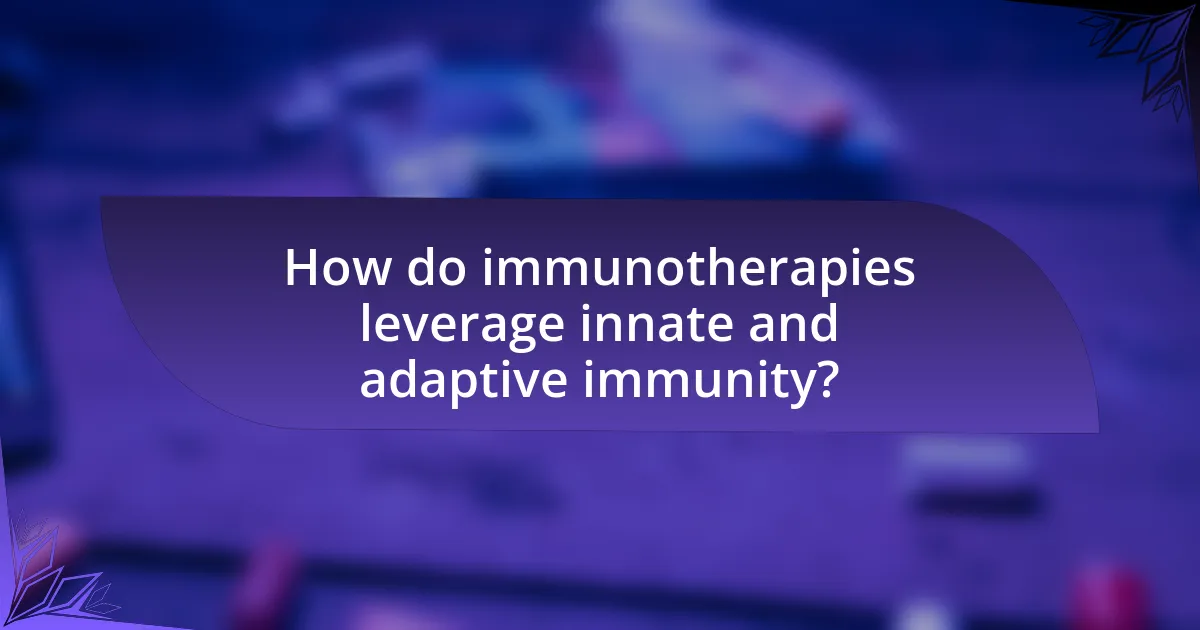
How do immunotherapies leverage innate and adaptive immunity?
Immunotherapies leverage innate and adaptive immunity by activating the body’s natural defense mechanisms to target and eliminate cancer cells. Innate immunity is engaged through the recognition of tumor-associated antigens by immune cells such as dendritic cells and macrophages, which then present these antigens to T cells, thereby initiating an adaptive immune response. This process is exemplified by checkpoint inhibitors, which block inhibitory signals on T cells, enhancing their ability to attack tumors. Additionally, therapies like CAR T-cell therapy modify T cells to improve their recognition and destruction of cancer cells, demonstrating the synergy between innate recognition and adaptive response. The effectiveness of these therapies is supported by clinical evidence showing improved patient outcomes in various cancers, highlighting the critical role of both immune systems in combating malignancies.
What types of immunotherapies exist?
There are several types of immunotherapies, including monoclonal antibodies, checkpoint inhibitors, cancer vaccines, adoptive cell transfer, and cytokine therapies. Monoclonal antibodies target specific antigens on cancer cells, enhancing the immune response against them. Checkpoint inhibitors block proteins that inhibit immune responses, allowing T cells to attack tumors more effectively. Cancer vaccines stimulate the immune system to recognize and destroy cancer cells. Adoptive cell transfer involves modifying a patient’s immune cells to better fight cancer. Cytokine therapies use signaling proteins to enhance the immune response. Each type plays a distinct role in harnessing the body’s immune system to combat diseases, particularly cancer.
How do checkpoint inhibitors utilize adaptive immunity?
Checkpoint inhibitors utilize adaptive immunity by blocking inhibitory pathways that prevent T cells from effectively attacking cancer cells. These inhibitors, such as anti-PD-1 and anti-CTLA-4 antibodies, enhance T cell activation and proliferation, allowing for a stronger immune response against tumors. Research has shown that by inhibiting these checkpoints, the adaptive immune system can recognize and eliminate cancer cells more efficiently, leading to improved patient outcomes in various cancers. For instance, studies have demonstrated that patients receiving anti-PD-1 therapy exhibit increased T cell activity and tumor regression, highlighting the critical role of adaptive immunity in the efficacy of checkpoint inhibitors.
What role do cytokine therapies play in innate immunity?
Cytokine therapies enhance innate immunity by modulating the activity of immune cells such as macrophages, dendritic cells, and natural killer cells. These therapies utilize cytokines, which are signaling molecules that facilitate communication between cells in the immune system, to boost the body’s natural defense mechanisms against pathogens and tumors. For instance, interleukin-2 (IL-2) and interferons are commonly used cytokines that promote the proliferation and activation of immune cells, thereby increasing their ability to respond to infections and malignancies. Research has shown that cytokine therapies can lead to improved outcomes in various conditions by enhancing the innate immune response, as evidenced by studies demonstrating increased survival rates in cancer patients receiving IL-2 treatment.
How do combination therapies enhance efficacy?
Combination therapies enhance efficacy by simultaneously targeting multiple pathways or mechanisms involved in disease processes, leading to improved therapeutic outcomes. For instance, in cancer treatment, combining immune checkpoint inhibitors with targeted therapies can increase tumor response rates by activating both innate and adaptive immune responses. Research has shown that such combinations can lead to synergistic effects, where the combined impact is greater than the sum of individual treatments, as evidenced by clinical trials demonstrating improved survival rates in patients receiving combination immunotherapy compared to monotherapy.
What are the benefits of combining innate and adaptive approaches?
Combining innate and adaptive approaches enhances the effectiveness of immunotherapies by leveraging the strengths of both immune systems. The innate immune response provides immediate defense against pathogens and tumor cells, while the adaptive immune response offers specificity and memory, leading to long-lasting protection. This synergy can result in improved tumor recognition, enhanced immune activation, and a more robust and sustained anti-tumor response. For instance, studies have shown that therapies targeting both arms of the immune system can lead to better clinical outcomes in cancer treatment, as evidenced by increased survival rates in patients receiving combination therapies compared to those receiving single-agent treatments.
How do these combinations affect immune response dynamics?
Combinations of innate and adaptive immune therapies enhance immune response dynamics by promoting synergistic effects that improve overall efficacy. For instance, the use of checkpoint inhibitors alongside cytokine therapies can lead to increased T-cell activation and proliferation, resulting in a more robust anti-tumor response. Research has shown that combining these therapies can lead to improved survival rates in cancer patients, as evidenced by studies demonstrating that patients receiving both types of therapies exhibit higher rates of tumor regression compared to those receiving monotherapy. This interplay between innate and adaptive immunity is crucial for developing effective immunotherapeutic strategies.
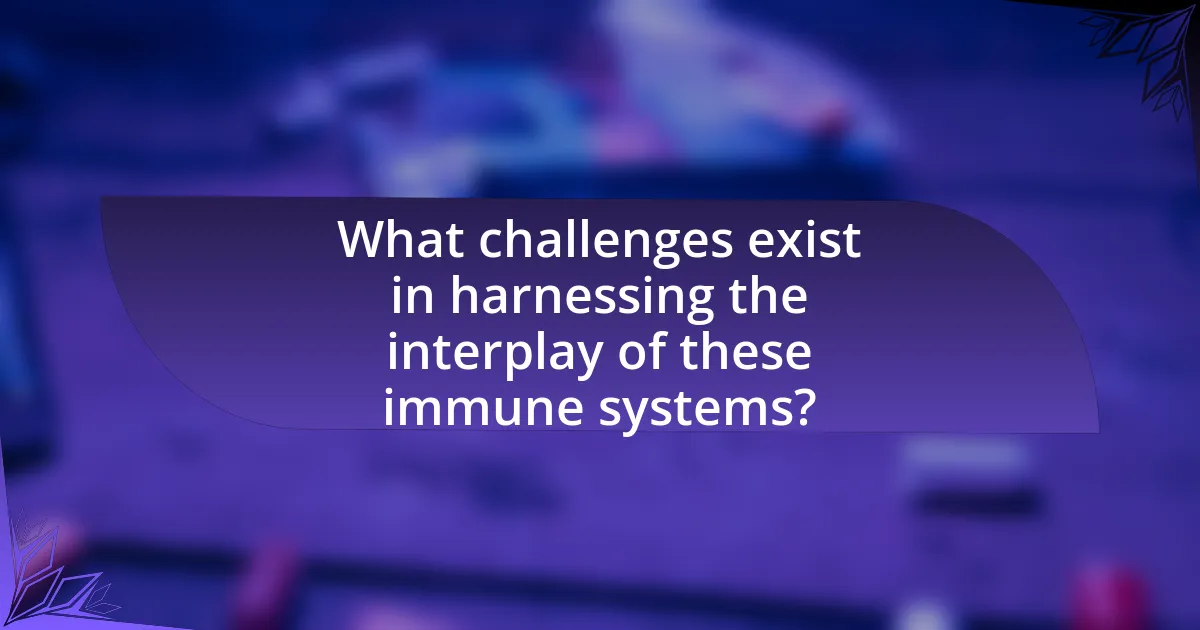
What challenges exist in harnessing the interplay of these immune systems?
Challenges in harnessing the interplay of innate and adaptive immune systems include the complexity of immune responses, potential for autoimmunity, and the difficulty in achieving a balanced activation of both systems. The immune response is highly regulated, and dysregulation can lead to ineffective therapies or harmful side effects. For instance, therapies that enhance innate immunity may inadvertently suppress adaptive responses, leading to suboptimal outcomes in cancer treatment. Additionally, the variability in individual immune responses complicates the development of universal immunotherapies, as genetic and environmental factors can influence how these systems interact.
What are the limitations of current immunotherapy strategies?
Current immunotherapy strategies face several limitations, including variability in patient response, potential for immune-related adverse effects, and challenges in targeting specific tumor antigens. Variability in patient response is evident, as not all patients benefit from immunotherapy; studies show that only about 20-30% of patients with certain cancers respond effectively to checkpoint inhibitors. Immune-related adverse effects can lead to autoimmune conditions, complicating treatment and patient management. Additionally, the difficulty in identifying and targeting specific tumor antigens limits the effectiveness of therapies, as tumors can evolve and escape immune detection. These limitations highlight the need for ongoing research to enhance the efficacy and safety of immunotherapy approaches.
How can immune evasion by tumors impact treatment?
Immune evasion by tumors significantly impacts treatment by allowing cancer cells to survive and proliferate despite the host’s immune response. Tumors can employ various mechanisms, such as downregulating major histocompatibility complex (MHC) molecules, producing immunosuppressive factors, or recruiting regulatory T cells, which inhibit effective immune responses. For instance, studies have shown that tumors with low MHC expression can escape detection by cytotoxic T lymphocytes, leading to treatment resistance. This evasion complicates the effectiveness of immunotherapies, as these treatments rely on the immune system’s ability to recognize and attack cancer cells. Consequently, understanding the mechanisms of immune evasion is crucial for developing more effective therapeutic strategies that can overcome these barriers.
What side effects arise from manipulating immune responses?
Manipulating immune responses can lead to a range of side effects, including autoimmune reactions, where the immune system mistakenly attacks healthy tissues. This occurs because enhancing immune activity can disrupt the balance between innate and adaptive immunity, leading to an overactive immune response. For instance, therapies like checkpoint inhibitors can cause conditions such as colitis, pneumonitis, and dermatitis, as documented in clinical studies. These side effects highlight the risks associated with immunotherapy, where the intended enhancement of immune function can inadvertently result in harmful consequences to the host.
How can future research improve immunotherapy outcomes?
Future research can improve immunotherapy outcomes by focusing on the mechanisms that enhance the synergy between innate and adaptive immunity. Understanding how innate immune cells, such as dendritic cells and macrophages, can effectively prime adaptive immune responses is crucial. For instance, studies have shown that enhancing the activation of dendritic cells can lead to stronger T-cell responses, which are vital for effective immunotherapy. Additionally, research into biomarkers that predict patient responses to immunotherapy can help tailor treatments to individual patients, thereby increasing efficacy. A study published in “Nature Reviews Immunology” by Chen et al. (2020) emphasizes the importance of targeting both arms of the immune system to achieve better therapeutic outcomes.
What innovative approaches are being explored?
Innovative approaches being explored in the context of immunotherapies include the development of combination therapies that integrate innate and adaptive immune responses. Researchers are investigating the use of checkpoint inhibitors alongside cytokine therapies to enhance T-cell activation and improve tumor recognition. For instance, studies have shown that combining anti-PD-1 antibodies with interleukin-2 can lead to increased anti-tumor activity, as evidenced by clinical trials demonstrating improved patient outcomes in melanoma treatment. Additionally, the application of personalized cancer vaccines that stimulate both arms of the immune system is gaining traction, with evidence suggesting that these vaccines can elicit robust immune responses tailored to individual tumor antigens.
How can personalized medicine enhance treatment effectiveness?
Personalized medicine enhances treatment effectiveness by tailoring therapies to individual patient characteristics, including genetic, environmental, and lifestyle factors. This approach allows for more precise targeting of treatments, leading to improved outcomes and reduced adverse effects. For instance, studies have shown that patients with specific genetic mutations respond better to targeted therapies, such as those used in cancer treatment, where drugs like trastuzumab are effective only in patients with HER2-positive tumors. This specificity not only increases the likelihood of treatment success but also minimizes unnecessary exposure to ineffective therapies, thereby optimizing resource utilization in healthcare.
What best practices should be considered when developing immunotherapies?
When developing immunotherapies, best practices include a thorough understanding of the immune system’s innate and adaptive components, as well as the mechanisms of action involved. Researchers should prioritize the identification of specific tumor antigens to enhance the targeting of therapies, ensuring that the immune response is both effective and specific. Additionally, optimizing the delivery methods of immunotherapeutics is crucial for maximizing efficacy while minimizing side effects.
Clinical trials must be designed with robust endpoints to evaluate both safety and efficacy, incorporating biomarkers that can predict patient responses. Continuous monitoring of immune responses during treatment is essential to adapt strategies as needed. Evidence from studies, such as those published in “Nature Reviews Immunology,” highlights the importance of these practices in improving patient outcomes and advancing the field of immunotherapy.
